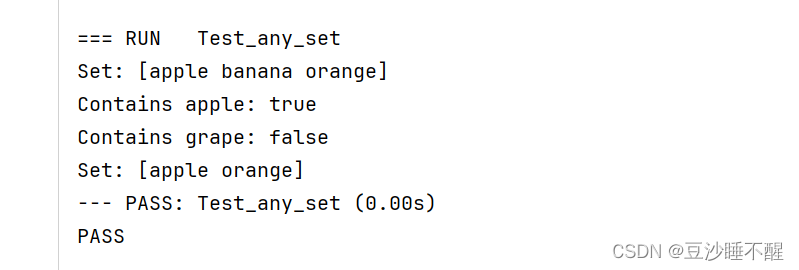s t r u c t struct struct是 G o l a n g Golang Golang里的关键字,用于定义结构类型
比如
type Student struct{id intname string
}
struct{}是有 0 0 0个元素的结构体.
struct{}{}表示类型struct{}的值为空{}
1.性质
1.1不占用内存
大小为 0 0 0,不需要内存来存储struct{}类型的值。
func Test_Size(t *testing.T) {var x intvar y stringvar z struct{}t.Log(unsafe.Sizeof(x), unsafe.Sizeof(y), unsafe.Sizeof(z)) //8 16 0
}

1.2 地址相同
定义两个struct{}类型的变量,打印并比较其地址,发现是相同的
func Test_Address(t *testing.T) {var x struct{}var y struct{}t.Logf("%p %p %v %v", &x, &y, &x == &y, x == y) // 0x1290460 0x1290460 true true
}

2.用途
2.1实现set
golang里没有实现set,如果在使用map的时候只关心key,不关心value的话,可以借助struct{}来实现set。比如key为string类型,那么set的实现map[string]struct{}。
因为struct{}不占用空间,所以在查找和判断的过程中速度会快,而且占用的内存也会小
简单实现:
func Test_set(t *testing.T) {set := make(map[string]struct{})set["a"] = struct{}{}if _, ok := set["a"]; ok {t.Log("exists") //exists}
}

使用interface{}实现
type Set map[interface{}]struct{}func (s Set) Add(item interface{}) {s[item] = struct{}{}
}func (s Set) Remove(item interface{}) {delete(s, item)
}func (s Set) Contains(item interface{}) bool {_, exists := s[item]return exists
}func Test_any_set(t *testing.T) {set := make(Set)set.Add("apple")set.Add("banana")set.Add("orange")fmt.Println("Set:", set)fmt.Println("Contains apple:", set.Contains("apple"))fmt.Println("Contains grape:", set.Contains("grape"))set.Remove("banana")fmt.Println("Set:", set)
}

使用泛型实现:
type Set[T comparable] map[T]struct{}func (s Set[T]) Add(v T) {s[v] = struct{}{}
}func (s Set[T]) Remove(v T) {delete(s, v)
}func (s Set[T]) Contains(v T) bool {_, ok := s[v]return ok
}func (s Set[T]) Len() int {return len(s)
}func (s Set[T]) Values() []T {values := make([]T, 0, s.Len())for v := range s {values = append(values, v)}return values
}func Test_any_set(t *testing.T) {s := Set[string]{}s.Add("apple")s.Add("banana")s.Add("orange")fmt.Println("Set:", s.Values())fmt.Println("Contains apple:", s.Contains("apple"))fmt.Println("Contains grape:", s.Contains("grape"))s.Remove("banana")fmt.Println("Set:", s.Values())
}

2.2. 用于无数据的channel
有的时候 c h a n n e l channel channel不需要发送数据,只需要一个触发信号,就可以使用struct{}来减少信号传递过程中的内存开销
a. 等待协程完成
w o r k e r worker worker函数是一个协程,它会模拟一些工作并在完成后发送空结构体值到 d o n e done done通道。
在 T e s t _ w a i t Test\_wait Test_wait函数中,我们通过从 d o n e done done通道接收空结构体值来等待工作完成。
func worker(done chan struct{}) {fmt.Println("Worker: Performing some work...")time.Sleep(2 * time.Second)fmt.Println("Worker: Work completed!")done <- struct{}{} // 发送空结构体值表示工作完成
}
func Test_wait(t *testing.T) {done := make(chan struct{})go worker(done)<-done // 接收空结构体值,等待工作完成t.Log("Main: Done!")
}

b.触发事件
w a i t F o r E v e n t waitForEvent waitForEvent函数会等待接收到空结构体值,表示事件发生。
t r i g g e r E v e n t triggerEvent triggerEvent函数会在一段时间后发送空结构体值到event通道,表示事件发生。
通过使用空结构体值作为通道元素,我们可以简单地实现事件的触发和等待。
func waitForEvent(event chan struct{}) {fmt.Println("Waiting for event...")<-event // 等待接收到空结构体值,表示事件发生fmt.Println("Event received!")
}func triggerEvent(event chan struct{}) {time.Sleep(2 * time.Second)fmt.Println("Triggering event...")event <- struct{}{} // 发送空结构体值,表示事件发生
}
func Test_event(t *testing.T) {event := make(chan struct{})go waitForEvent(event)go triggerEvent(event)time.Sleep(3 * time.Second)
}
2.3 方法接收器
实现一个接口,只需要实现一些方法,不用声明一些额外的数据,可以用struct{}来实现,也可以换成其他任意的变量,比如 i n t int int , b o o l bool bool
type Animal interface {Shouting()
}
type Dog struct{}func (dog *Dog) Shouting() {fmt.Println("wang wang wang")
}

)









)





)

